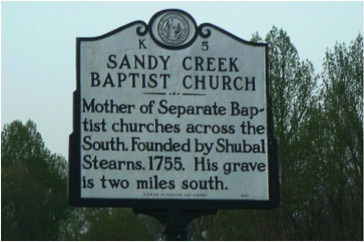
The Separate Baptist Revivals in the South,
1750-1790
Garry D. Nation

John Leland was “the great harvester,” and perhaps the catalyst for the revivals that began springing up after the Revolution. He returned to Massachusetts in 1792 but not before he had, among other accomplishment, baptized 700 people and stirred many hearts. He made a productive tour of the central counties of North Carolina in 1785, and in 1786 teamed with Samuel Harris for a tour through several Virginia counties where “there preaching awakened many.”1
The Separate Baptists participated in a chain of awakenings along Virginia's James River Valley from 1785 off and on until 1792. The Ketockton Regular Baptist also got caught up in the revival and led it in the northern regions of its spread. “The revival checked the spread of Methodism in most of Virginia, and it consolidated the position of the Baptists as the largest Christian body in the state.”2
Townsend speaks of a revival in South Carolina that “began through the rapid formation of churches and addition of members, reching its climax in 1789.” 3 Some of the first settlers on the western frontier had been Separate Baptists, including the Daniel Boone family, and in 1785 and 1788 the Baptists in Kentucky experienced their own revival under the leadership of John Taylor.
Lumpkin lists several significant features of these later revivals. The physical and emotional demonstrations were present again, and not uncommonly a great deal of disorder as well. But this time there not everything was automatically accepted as being of God, and churches were more self-critical and discriminating. Warnings of hypocrisy were issued, and extreme manifestations were shunned. The Separates became more orderly, partly because they had become more socialized. They were no longer the lowest socio-economic group in the county; they were becoming more middle class, more respectable. Music was more important than before, and people sang on their way to the meetings, sang at the meetings, and sang on the way home. 4
The postwar revivals also saw the strengthening of Calvinistic doctrines among the Separates, and their unifying with the Regulars. But they did not produce as many young preachers as had the former revivals that poured forth new men into the ministry like a stream. Leland had his own opinion why it was so: first, the old preachers stood occupied all the places of leadership and there were few openings for them; second, the people had slacked off their prayers for new laborers; third (and this was his greatest complaint), it was God's judgment on the people who held on to their old prejudice against paying their ministers. Lumpkin adds his own point that young men were pursuing their fortunes westward on the frontier rather than souls in the settlements.5
Previous: The Revolutionary Period
NOTES
1 Lumpkin, 135.
2 Ibid., 136.
3 Townsend, 296.
4 Lumpkin, 137.
5 Ibid.
- VII-
"That Your Fruit Should Remain"
The Post-War Period, 1781-1790
